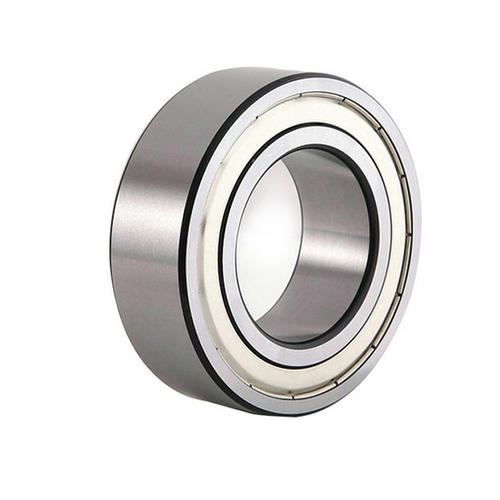CONTACT US
Zhejiang waxing electromechanical co.LTD.,Factory located in Shandong,Headquarters located in Zhejiang,China.

There are two kinds of axial preloading force of bearings. One is constant pressure preloading force, and the other is positioning preloading force.Under constant pressure preloading, the radial stiffness of the bearing increases slightly with the increase of rotational speed, while the axial and angular stiffness decrease rapidly.Under positioning preloading, the radial, axial and angular stiffness of bearings increase rapidly with the increase of rotational speed, but the increase of axial and angular stiffness is relatively gentle.
1. Influence of preload
With the increase of the preload, the radial, axial and angular stiffness of the bearing increase slightly, but the influence is very small.Compared with positioning preloading, this effect is more significant for constant pressure preloading.This is because the increase of the preload increases the contact Angle of the inner and outer rings, as well as the increase of the contact load, which increases the radial, axial and angular stiffness.However, the change of contact load and contact Angle caused by the preload is small compared with the change caused by the rotation speed and the displacement of parts, so the influence on bearing stiffness is limited.This is also the reason why the change under positioning preloading is less than that under constant pressure preloading.
2. Influence of the radius of curvature of the channel
With the increase of the radius of curvature of the inner and outer ring channel, the radial, axial and angular stiffness decreases, but this effect is very small. Only in the case of positioning preloading, the change of stiffness is slightly more obvious, which is because the increase of the radius of curvature of the channel increases the contact deformation.Therefore, the influence of channel curvature radius on stiffness can be ignored when choosing channel curvature radius generally.
3. Influence of the number of balls
The radial, axial and angular stiffness increases slightly with the increase of the number of balls under preloading.The increase in the number of balls will increase the stiffness, but the same preload, the increase in the number of balls will reduce the contact load, although their combined effect can increase the stiffness of the bearing, but less.
Under constant pressure preloading, the radial stiffness increases significantly with the increase of the number of balls, while the axial and angular stiffness decrease with the increase of rotation speed to a certain value, but the change is very small.This is because, under constant pressure preloading, the increase of balls makes the inner ring contact load decrease, but at the same time makes the inner ring contact Angle decrease. Their combined action makes the radial stiffness of the bearing significantly increase, while the axial and angular stiffness slightly decrease.
Therefore, when the number of balls increases, the preload should be increased correspondingly. Only when the contact load is the same, the bearing stiffness can be increased by increasing the number of balls.
4. Influence of ball diameter
The radial, axial and angular stiffness of the ball increased slightly with the increase of ball diameter under preloading.As the ball diameter increases, the centrifugal force of the ball increases, the contact Angle of the outer ring decreases, and the contact Angle of the inner ring increases, but the contact load of the inner and outer rings increases at the same time. The combined effect of the two increases the bearing stiffness.The centrifugal force change has little effect on the contact load under the condition of positioning preloading, so the ball diameter change has little effect on the stiffness.
Under constant pressure preloading, the radial stiffness increases with the increase of ball diameter, while the axial and angular stiffness decrease, but the influence is small.This is because the centrifugal force of the ball increases with the increase of the ball diameter, the contact Angle of the inner and outer rings decreases, and the contact load of the outer ring increases, while the contact load of the inner ring is basically unchanged, so the radial stiffness increases, while the axial and angular stiffness slightly decreases.Therefore, reducing the ball diameter not only improves the velocity performance, but also does not reduce the stiffness performance.This also proves theoretically that the reduced small ball is one of the development trends of spindle bearings.
5. Influence of initial contact Angle
When the initial contact Angle increases, the radial stiffness decreases significantly, while the axial and angular stiffness increase significantly.As the initial contact Angle increases, the radial component of the contact stiffness decreases while the axial component increases. At the same time, the contact load decreases under the same preload.
Under constant pressure preloading, the increase of initial contact Angle makes the radial stiffness decrease significantly.At low speed, the axial and angular stiffness increases, but at high speed, it is almost unchanged.This is because under constant pressure preloading, the inner and outer rings allow axial displacement. In order to maintain the balance of forces, the contact Angle of the outer ring is almost close to zero, and the initial contact Angle has little effect on the contact Angle of the outer ring.Similarly, when the initial contact Angle increases, the contact load decreases under the same preload.
Therefore, increasing the initial contact Angle of the bearing can improve the axial and angular stiffness under positioning preloading, while increasing the initial contact Angle can not improve the axial and angular stiffness under constant pressure preloading, but reduce the radial stiffness.
Copyright © 2025 Zhejiang waxing electromechanical co.LTD. | All Rights Reserved Design
Hello, please leave your name email or WhatsApp here before chat online so that we won't miss your message and contact you smoothly.